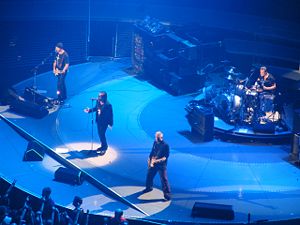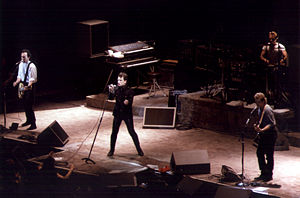Talk:U2: Difference between revisions
imported>Anton Sweeney (→Anton, I have been bold.: Great :-)) |
imported>Robert W King No edit summary |
||
| Line 1: | Line 1: | ||
{{subpages}} | |||
[[Image:U2 Live in Toronto 2005 (1).jpg|right|thumb|300px|U2 Live in Toronto 2005{{U2 Live in Toronto 2005 (1).jpg/credit}}]] [[Image:U2 Live in Toronto 2005 (3).jpg|right|thumb|300px|Blue color adjusted from above.{{U2 Live in Toronto 2005 (3).jpg/credit}}]] | [[Image:U2 Live in Toronto 2005 (1).jpg|right|thumb|300px|U2 Live in Toronto 2005{{U2 Live in Toronto 2005 (1).jpg/credit}}]] [[Image:U2 Live in Toronto 2005 (3).jpg|right|thumb|300px|Blue color adjusted from above.{{U2 Live in Toronto 2005 (3).jpg/credit}}]] | ||
[[Image:U2 at the San Francisco Civic Auditorium 15 December 1984.jpg|right|thumb|300px|U2 at the San Francisco Civic Auditorium 15 December 1984.{{U2 at the San Francisco Civic Auditorium 15 December 1984.jpg/credit}}]] | [[Image:U2 at the San Francisco Civic Auditorium 15 December 1984.jpg|right|thumb|300px|U2 at the San Francisco Civic Auditorium 15 December 1984.{{U2 at the San Francisco Civic Auditorium 15 December 1984.jpg/credit}}]] | ||
Revision as of 15:40, 7 October 2007
Also available is this photo. —Stephen Ewen (Talk) 22:59, 5 October 2007 (CDT)
Idea: Influence of Eno and Lanois
Lovely article! And the pictures are superb. I have an idea. Shall I write about Brian Eno's role (and Daniel Lanois') in the development of U2? (It was Eno's idea to bring Lanois into the project with him, I recall.) Or would someone else like to do it? Soon I shall start a Brian Eno page (unless someone beats me to it); I have watched his remarkable career closely for over twenty years. I suppose it could be argued (politely, calmly, haha) that Eno and Lanois were the extra added elements that augmented U2 into supergroup status (the one-two punch of The Unforgettable Fire and especially The Joshua Tree). Those two albums were the "turning point" as it were, right? Eno and Lanois did for U2 what Eno did for the Talking Heads not many years previously. Isn't it also (at least kind of) accurate to describe Eno as a kind of "fifth member" of U2, especially during "Unforgettable Fire" (for example, we can hear him in the background during "Pride")? This is often the way Eno approaches (and describes) his production duties. Quotes by Eno and U2 will have to be found to back up these thoughts. Which, at this point, are just humble thoughts. I'll leave it up to the originator(s) of the page. Happy writing!Jeffrey Scott Bernstein 09:38, 7 October 2007 (CDT)
- Jeffrey, please be bold and add material Lanois and Eno - their early influence was indeed hugely important around the TUF and TJT. Anton Sweeney 11:42, 7 October 2007 (CDT)
Anton, I have been bold.
I have produced something on Eno and Lanois. I wonder what you will think of it! I shall post it here for your consideration. Feel free, of course, to do with it what you will. Here goes:
New Direction: Enter Eno and Lanois
After the hard loud rock and roll sound of War, U2 felt themselves standing at a career crossroads; for their fourth studio album they desired to explore new musical directions, but were unsure how to proceed. The band’s gut feeling was an unorthodox one: they chose to approach the avant-garde, cerebral Brian Eno. Although Eno was indeed one of the most innovative and acclaimed of modern musicians, his music was in sound and spirit very different from the U2 of War.
At face value, U2 and the English-born Eno were worlds apart. While U2 were raw and fiery with guitars and drums, Eno, a technical genius, built home-made machines to create new sounds, forever experimenting with new technological ways of generating music. He had proven himself to be a wizard of the production studio who brought out the best in whoever artist he produced (such as David Bowie and then the Talking Heads, for example), but by the time U2 came calling, Eno was busy exploring what he called “ambient music”, creating odd soundscapes and entrancing atmospheric sonic textures that were mellow and contemplative, far from either hard rock or catchy tunes. At first Eno had no desire to work with U2, preferring to continue on with his ambient music in collaboration with the immensely talented but still relatively unknown Canadian musician Daniel Lanois, who preferred spare and folksy melodies. U2 somehow persuaded Eno to produce their next album, and Eno brought Lanois with him.
“They were ready to embrace some new colours,” Lanois recalled, years later. [1] Eno and Lanois acted as guides for a new musical direction for U2. Eno and Lanois, approaching the project as more than simply producers and engineers, virtually became the fifth and sixth members of the band, contributing backing vocals and playing instruments. The marriage of the formerly gritty and gutsy U2 with the mystical and contemplative Eno and Lanois led to the richly atmospheric and passionate The Unforgettable Fire (1984). Its first single, “Pride (In the Name of Love)” (in which Eno can be heard singing in the background), became U2’s biggest hit yet, breaking into the American top 50 and rising to number 33. The collaboration which Eno had first frowned upon had flourished magnificently. U2 had altered artistically; they now had a deeper, richer, more lyrical and mesmerizing sound. But the great success of The Unforgettable Fire would be mere prelude to the band’s second collaboration with Eno and Lanois: The Joshua Tree.
Eno and Lanois + U2 = Bigger and Better
U2’s fifth studio album, The Joshua Tree (1987) was the groundbreaking moment in U2’s career, their defining, decisive moment. A spectacular success, The Joshua Tree became their first number one album in both the U.K. and the U.S., sold over 25 million copies worldwide, and gave the band their first number one singles in America: “With or Without You” (with its Eno-esque atmosphere) and then the more Lanois-oriented “I Still Haven’t Found What I’m Looking For.” It was The Joshua Tree that firmly fixed U2 in the admiring eyes of the world. The Joshua Tree won the Grammy for Album of the Year, the highest honor the music industry can bestow. At the moment U2 were at the top, they had reached the pinnacle of musical success, playing to sold-out stadiums across the globe.
Eno once described U2 as “looking for a way to unlock something that they suspect is in their music, but they can’t quite get out.” [2] Eno and Lanois got it out. (Lanois once mused: “ ‘What is it that you do?’ people say. My answer is, ‘I raise the spirit.’") [3] Eno and Lanois helped raise U2 up into the biggest band in the world. With the continuing collaboration of their two super-genius producers, U2 would retain that superior position for many years to come.Jeffrey Scott Bernstein 16:11, 7 October 2007 (CDT)
- Very nice, Jeffrey - I'll incorporate it tomorrow :-) Regards, Anton Sweeney 16:13, 7 October 2007 (CDT)
- ↑ http://www.licc.org.uk/culture/daniel-lanois] “ They wanted a greater emotional perspective in their music,” Eno explained. [http://music.hyperreal.org/artists/brian_eno/interviews/musn88h.html
- ↑ http://music.hyperreal.org/artists/brian_eno/interviews/musn88h.html.
- ↑ http://www.licc.org.uk/culture/daniel-lanois.


